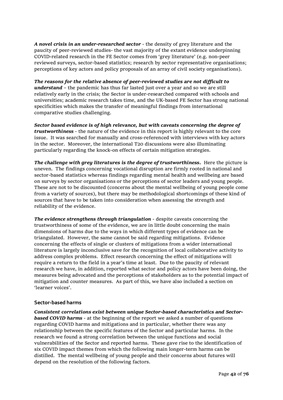
Page 42 of 76
A novel crisis in an under-researched sector - the density of grey literature and the
paucity of peer-reviewed studies- the vast majority of the extant evidence underpinning
COVID-related research in the FE Sector comes from 'grey literature' (e.g. non-peer
reviewed surveys, sector-based statistics; research by sector representative organisations;
perceptions of key actors and policy proposals of an array of civil society organisations).
The reasons for the relative absence of peer-reviewed studies are not difficult to
understand - the pandemic has thus far lasted just over a year and so we are still
relatively early in the crisis; the Sector is under-researched compared with schools and
universities; academic research takes time, and the UK-based FE Sector has strong national
specificities which makes the transfer of meaningful findings from international
comparative studies challenging.
Sector based evidence is of high relevance, but with caveats concerning the degree of
trustworthiness - the nature of the evidence in this report is highly relevant to the core
issue. It was searched for manually and cross-referenced with interviews with key actors
in the sector. Moreover, the international T20 discussions were also illuminating
particularly regarding the knock-on effects of certain mitigation strategies.
The challenge with grey literatures is the degree of trustworthiness. Here the picture is
uneven. The findings concerning vocational disruption are firmly rooted in national and
sector-based statistics whereas findings regarding mental health and wellbeing are based
on surveys by sector organisations or the perceptions of sector leaders and young people.
These are not to be discounted (concerns about the mental wellbeing of young people come
from a variety of sources), but there may be methodological shortcomings of these kind of
sources that have to be taken into consideration when assessing the strength and
reliability of the evidence.
The evidence strengthens through triangulation - despite caveats concerning the
trustworthiness of some of the evidence, we are in little doubt concerning the main
dimensions of harms due to the ways in which different types of evidence can be
triangulated. However, the same cannot be said regarding mitigations. Evidence
concerning the effects of single or clusters of mitigations from a wider international
literature is largely inconclusive save for the recognition of local collaborative activity to
address complex problems. Effect research concerning the effect of mitigations will
require a return to the field in a year's time at least. Due to the paucity of relevant
research we have, in addition, reported what sector and policy actors have been doing, the
measures being advocated and the perceptions of stakeholders as to the potential impact of
mitigation and counter measures. As part of this, we have also included a section on
'learner voices'.
Sector-based harms
Consistent correlations exist between unique Sector-based characteristics and Sectorbased
COVID harms - at the beginning of the report we asked a number of questions
regarding COVID harms and mitigations and in particular, whether there was any
relationship between the specific features of the Sector and particular harms. In the
research we found a strong correlation between the unique functions and social
vulnerabilities of the Sector and reported harms. These gave rise to the identification of
six COVID impact themes from which the following main longer-term harms can be
distilled. The mental wellbeing of young people and their concerns about futures will
depend on the resolution of the following factors.